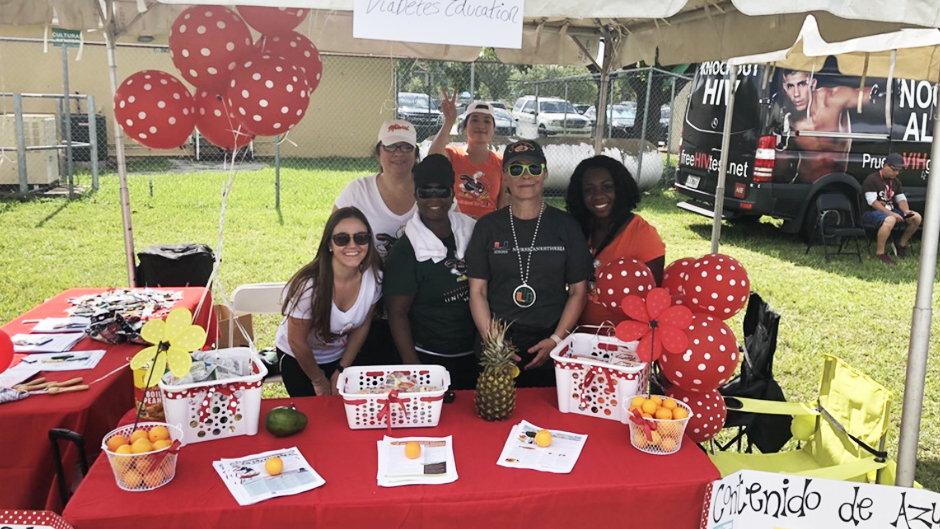The rain couldn’t dampen Catherine Nadeau’s enthusiasm for her mission. “Don’t let the clouds and wind fool you,” advised the family nurse practitioner, handing out slightly soggy pamphlets titled “The Sun’s Hot. Skin Cancer’s Not.” “The UV index is actually 8 right now, even though it’s pouring on us!”
Sporting her white coat, Nadeau, MSN ’17, a lecturer at UM’s School of Nursing and Health Studies (SONHS), stood at a water-logged booth in an open field in rural Homestead showing area residents how to check for suspicious marks, including in often-overlooked spots like the hairline. “The activity was interactive,” she said, “so hopefully people will remember the information.”
Nadeau was one of 45 Doctor of Nursing Practice (DNP) students from SONHS who helped organize and staff a free Community Health Fair on June 23 in collaboration with M.U.J.E.R., a Homestead-based social service organization.
Discussing a variety of health-related topics with members of the mainly Latino community, the students distributed first-aid kits, dental floss, even UV-light-detecting keychains. One booth had a working sink to demonstrate proper hand-washing technique and other hygiene tips to ward off illness and infection. The UHealth Pediatric Mobile Clinic was on site to administer free vision checks and flu shots.
DNP student Evens Mesadieu, BSN ’09, distributed bilingual pamphlets showing figures modeling proper body mechanics. “There are many farmworkers in this area,” he said. “This explains how to bend down to pick up boxes, for example, so they don’t hurt their backs.”
“The experience was wonderful,” said SONHS associate professor Rosina Cianelli, Ph.D., MPH, RN, IBCLC, FAAN. “We had a much higher turnout from the community than we expected, even with the rainy weather. And the DNP students did fantastic work. They created innovative booths on a variety of health issues. They also brought in a huge donation of food for the community.”
The students’ participation was part of their work for Cianelli’s Population Based Health and Health Care Disparities course. Besides promoting good health and fun activities for local families, the health fair accomplished a bigger goal: to help bridge the gap for groups historically underrepresented in biomedical research.
The fair was the brainchild of Cianelli and Natalia Villegas, Ph.D. ’12, MS, RN, IBCLC, SONHS associate professor of clinical. Their outreach proposal was one of just six nationwide to receive a competitive mini-grant from the American Association of Colleges of Nursing (AACN) to support the landmark All of Us Research Program. The National Institutes of Health (NIH) launched All of Us in May to extend precision medicine to all diseases by developing a health research data set of a million or more participants who represent the diversity that exists throughout the United States.
Rick Garcia, Ph.D., director of nursing education at the Washington, D.C.-based AACN and a principal investigator for its All of Us grant, attended the Community Health Fair in June to discuss All of Us with fair attendees. During his Powerpoint presentation, Garcia, a SONHS alumnus (BSN ’95), explained in English and Spanish that minorities make up 36% of the U.S. population, with that number forecast to rise to 56% by 2060. But despite those increases, enrollment in clinical trials remains much lower for minorities—in “subzero territory,” pronounced one of the researchers interviewed in a video Garcia played for the audience.
Also featured in the video was NIH Director Francis Collins, M.D., Ph.D., who said the project offered a chance to be part of history. “Over the years, medicine has not really taken into account individual differences,” he admitted. The presentation also emphasized that the medical and research communities must take responsibility to gain the trust of minority populations, adding that communities of color will be at a disadvantage if they continue to be underrepresented in biomedical research data.
A key goal of the Community Health Fair was to engage 150 members of the Homestead rural community in meaningful conversations about All of Us. Despite downpours all day, said Cianelli, she and her team managed to discuss the initiative with 195 adult residents from the area. She credited the School’s Center for Latino Health Research Opportunities (CLaRO) and longstanding community partner M.U.J.E.R., whose representatives even went door-to-door with her to invite local families to the fair, for helping to ensure a great turnout.
The event’s many attendees, largely from Mexico and Central America, received a survey prior to Garcia’s presentation measuring how much they knew about biological research. They received another survey afterward to reassess their knowledge of the subject. They were then directed to the allofus.org website for more information and, if interested, to enroll as program participants.
“Having Dr. Garcia present the information was very effective because he knows the program,” said Villegas. “People were feeling empowered because he came to talk to them directly about this important program.”
Still, their positive response and openness surprised Villegas. “Usually people are not willing to be research participants, but the presentation made sense to them,” she said. “I had people coming up to me after, saying, ‘I want to participate.’ I think it was because they saw minorities represented, and the subject was discussed openly.”
With Latinos and other historically underrepresented minority groups suffering from higher-than-average rates of chronic diseases like hypertension, diabetes, and arthritis, said Cianelli, All of Us is an important initiative to keep discussing in our region.

